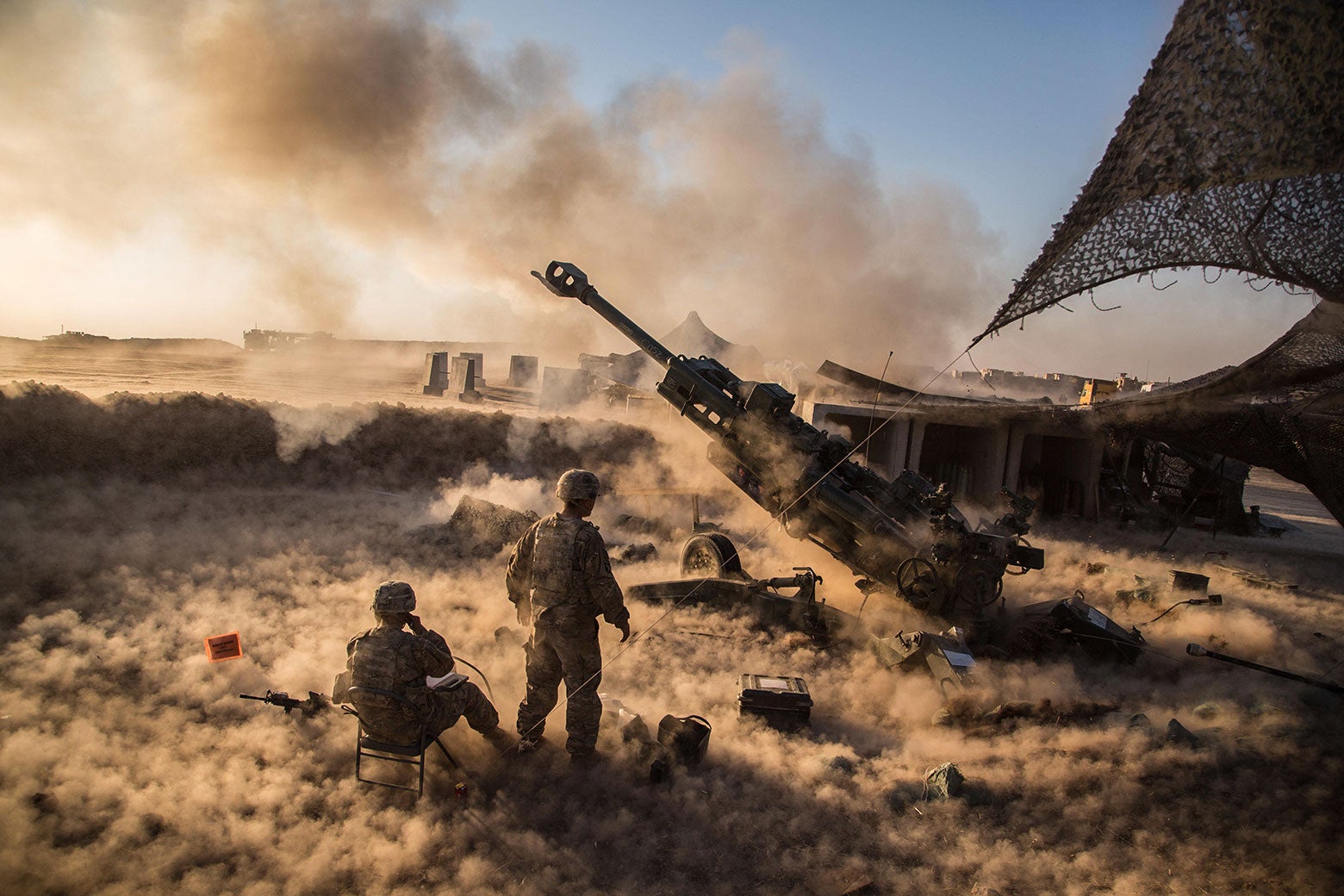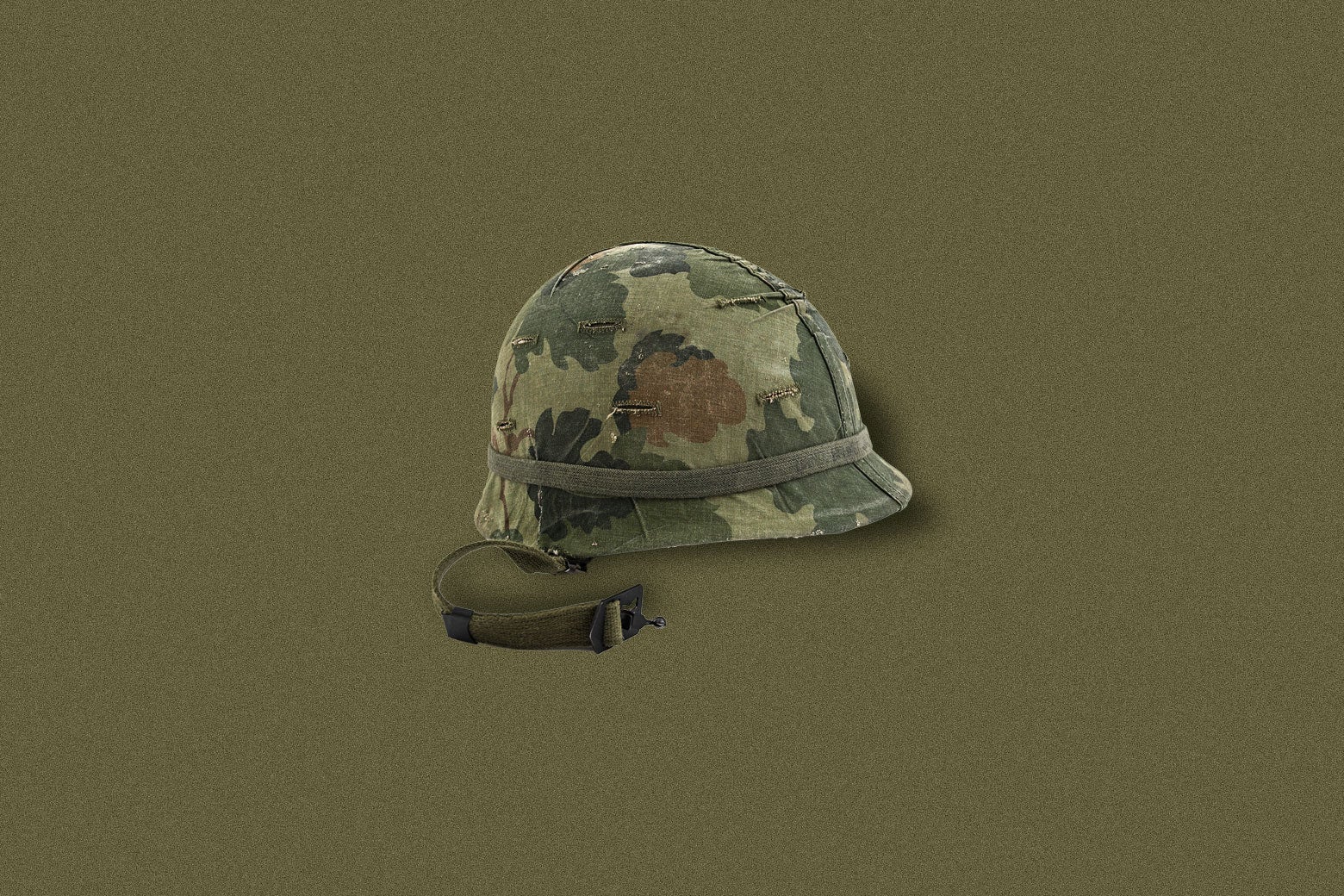Welcome to State of Mind, a section from Slate and Arizona State University dedicated to exploring mental health. Follow us on Twitter.
I’ll never forget the way my body felt after that blast inside a dugout trench in northern Iraq. It was 2016, and I was there as my unit’s journalist, accompanying Sgt. Joshua James and the seven other men in his team. Each time James and his section fired their artillery piece—a long-range cannon that could shoot high-explosive rounds for miles—the force of the explosion was so strong it knocked the breath out of me and caused a shudder in my bones. As the dust cloud began to form from the sand blown off the walls and ground, filling our noses and staining our uniforms, I also felt a dull pain in my head, like I had just gotten hit in the face.
Blast overpressure, it’s called: the “near-instantaneous pressure rise” in the area around an explosion, according to researchers. The men in James’ unit experienced it each time they stood feet away from their gun as it fired. During their nine-month deployment, the unit would launch shells toward their enemies around 6,000 times. As a result, some incurred noticeable concussions, and each blast had the potential to cause what the Centers for Disease Control now call “primary blast injury of the brain,” with symptoms similar to other types of mild traumatic brain injuries, or mTBIs: headaches, irritability, cognitive deficits, and even death.
Each brain injury suffered from blast exposure also increases the chances of a service member developing symptoms akin to those seen in Chronic Traumatic Encephalopathy, or even developing CTE itself. CTE, a degenerative brain disease, is understood as a driver behind negative mental health outcomes for NFL players, including Andre Waters, Junior Seau, and Aaron Hernandez. For the thousands of military personnel who serve in units like James’, the threat to brain health comes not only from IEDs or incoming artillery fire, but from their own weapons systems.
The Department of Defense has estimated that more than 380,000 personnel have suffered some sort of mTBI since the start of the War on Terror in 2001. Over that same period, the suicide rate among service members has skyrocketed. More than 30,177 service members and veterans who served during the War on Terror alone have died due to suicide, four times the number of troops lost in combat during that period. Importantly, not all these deaths are related to blast injuries—the military’s mental health crisis is complex and involves factors including military sexual trauma, poor leadership, combat exposure, quality of life issues, and many others. But medical research released in March found military personnel with mTBIs have a suicide rate that is almost three times the national average, and that risk is even higher if they seek care through the VA.
When they returned home from Iraq, half of the men in James’ eight-man section found themselves with mental health conditions such as depression and PTSD. One of them was James himself; on Nov. 15, 2022, James, age 35, died by suicide, the second in five years from his platoon of fewer than 30 people, leaving behind his wife and two young children. We may never know the exact role multiple blast overpressure events played in deaths like James’—in large part due to military failures which continue today.
The DoD has not properly documented the role of blast-related brain injuries in the military’s mental health crisis. This is despite explicit instruction by Congress to do so; for example, in 2020 Congress required the agency to include detailed records of troops’ blast exposure in their medical records. This tracking is critical for service members and veterans who want to receive treatment for their injuries. In February, the DoD released the findings from its Suicide Prevention and Response Independent Review Committee, a research program mandated by Congress. The report highlighted a lack of mental health workers and issues with the military’s promotion system and suicide prevention training, among other problems. But in discussing the next steps to be taken in light of the findings, the DoD did not highlight the effect of TBIs on suicide risk at all.
This omission is especially glaring because the DoD has known for years about the risks from blast exposure. In 2017, the same year James’ unit returned home, a Marine artillery unit in Syria found itself with multiple members stumbling around in a daze from concussions at times. Others began literally bleeding from their ears during the fighting. The DoD grew so concerned by the prevalence of these injuries that it conducted a study the following year on the Marines.
Their findings were startling: Based on the rate of head injuries the Marines in Syria suffered, the DoD estimated that an artillery crew firing at the same rate would find themselves with degraded combat abilities within three weeks and be almost totally ineffective in two months.
Furthermore, the report (based on service members’ medical records) highlighted that head injuries among these personnel began to occur during training, before they even got into combat. The DoD calculated that in a larger unit with similar demands, brain injuries could disable hundreds of personnel, and replacements could not be trained fast enough to make up for the losses.
The Syria report suggested having Marines wear devices that would notify a service member when they reached the maximum level of blast exposure in a 24-hour period, but that suggestion has effectively gone nowhere. In fact, simple helmet sensors that gather, monitor, record, and maintain data on blast pressure exposure have been available since at least 2009. But James and his unit weren’t even given these before they deployed. Put simply: Tech that could help aid in the diagnosis of concussions and TBIs should be widely distributed. It isn’t.

Spc. Christopher Brecht/U.S. Army
This wasn’t the only way the DoD failed James and his unit. Although the soldiers underwent a pre-Iraq health assessment that looked at neurological health, they told me there was no follow-up upon their return to analyze potential damage incurred during their deployment. (Pentagon policy requires such a follow-up if servicemembers display signs of a brain injury). Soldiers in James’ unit also told me that they were rebuffed or ignored when they asked their superiors about the post-deployment assessment, even as the military continued to send artillery units to the Middle East with combat tempos that were just as high as before. I had a similar experience: Three years after I returned from Iraq, I attempted to go to an on-base TBI clinic after suffering from headaches and dizziness, but I was refused treatment and analysis because I hadn’t “underwent evaluation in time,” the medical personnel at my unit told me. When I asked a Department of Defense spokesperson about these experiences in a telephone interview, they were surprised to hear the issues we had obtaining access to these assessments and told me the agency was moving toward a more holistic continuous evaluation system that isn’t just based on pre- and post-deployment health assessments.
As for the status of military brain-health initiatives, in the same interview the Department of Defense pointed me to interim guidance on managing brain risk from blast overpressure, which is meant to raise awareness of the issue among military personnel (there is no ETA for when this text will be finalized). This guidance, on one page, suggests units and commanders follow rules about explosive safety that have been in place for more than a decade. (These rules, the Syria report shows, have done little to keep service members truly safe from blasts.) Making potential interventions trickier, each service branch has different safety requirements—and in an email exchange, the DoD did not answer my question about what is being done to standardize policy.
In response to congressional efforts in 2018 and 2020, there has been some attempt to better document cognitive health. The DoD added a specific diagnostic code for primary blast injuries to the brain, which the DoD spokesperson said in the email would make such injuries easier to track. Before that change, blast history was regularly documented “as a mechanism of injury in the medical record, but no diagnostic code existed for blast injury to the brain specifically,” the spokesperson wrote. This progress is admirable, but the Pentagon’s own December 2022 statement to Congress acknowledges that lawmakers requested more than just a diagnostic code. The congressional correspondence also explained that monitoring and documentation of blast events had “not routinely included a measure of blast pressure” or tracked blast exposure history as the 2020 law had requested, and that there was no current ETA for when it would.
The science behind blast brain injuries is still developing, alongside knowledge of TBIs from other “physical” events, such as tackles, car accidents, or punches. Research suggests the recurrence of exposure matters. Injuries caused by objects around the blast are important, in addition to the pressure itself. And these injuries are hard to recover from. Although PTSD symptoms and TBIs are often concurrent, they are two separate phenomena with unclear influences on each other.
Further research, enabled by routine and widespread blast-pressure tracking, is especially urgent as militaries domestically and abroad shift toward relying more on artillery in current and potential future conflicts, including in the war in Ukraine.
The DoD often cites prospective recruits fearing for their safety—such as the expectation that they will develop mental health or other health issues due to military service—as a reason that it finds itself in a recruiting crisis, and this is a legitimate fear. By failing to complete even the bare minimum task given to it by Congress three years ago to begin tracking blast exposure correctly, the DoD has not fully supported service members like Joshua James and his unit. All the soldiers in the firing pit with me that day in northern Iraq were in their 20s or even teens. None had any idea that they were trading a piece of their future each time they fired.
The research is far enough along that the next generation of service members shouldn’t have to face such a destructive bargain.
If you need to talk, or if you or someone you know is experiencing suicidal thoughts, text the Crisis Text Line at 741-741 or call or text 988 to reach the Suicide & Crisis Lifeline.

